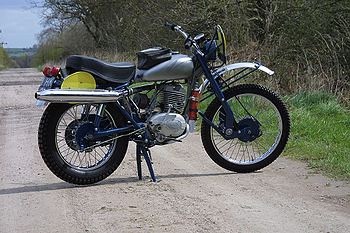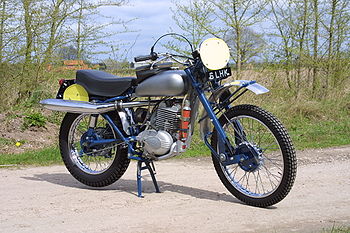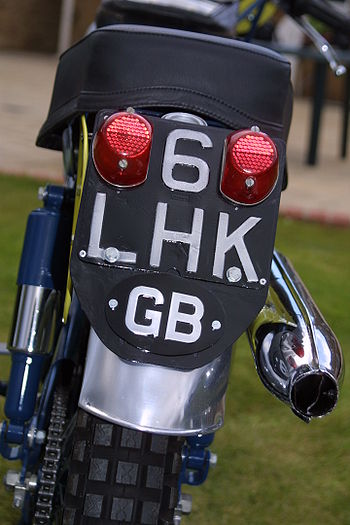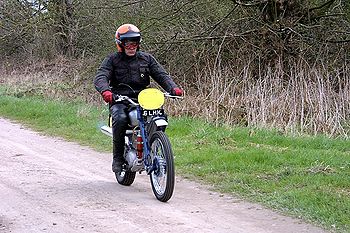6 LHK ex Brian Stonebridge 1958 ISDT Greeves
Despite the absence of a tank badge or name plate announcing the manufacturers name or model this is unmistakably a Greeves and arguably one of the most famous machines ever to emerge from the Thundersley works.
It bears the registration 6 LHK and is referred to by both ISDT and Greeves aficionados alike simply (and reverently) as ‘Number six’. It was built in 1958 as one of a batch of six registered in sequence 2 LHK – 7LHK for the 33rd International Six Days Trial in Germany where it was ridden by the legendary works rider Brian Stonebridge. Not only was it originally Stonebridge’s mount it was also the first works Greeves to be entered into this gruelling six day, 1200 mile event which was centred on Garmisch Partenkirchen in Bavaria. Stonebridge and fellow works man Jack Simpson (5 LHK) were selected for the British vase B team and travelled to the trial in style along with company boss Bert Greeves in his faithful old Ford V8 Pilot. In the days before luxury race transporters the bikes were carried on a trailer behind the Ford along with a third machine which wasn’t entered but ridden by Bert in his role as minder. It was not a good event for the British team with Jim Sheehan’s Velocette going out on day one with a fried clutch and following a spill Simpson was rushed to hospital with a badly bruised and lacerated leg which forced his retirement. But Stonebridge soldiered on and was rewarded with the ultimate accolade of a Gold medal: the first to be won by a Greeves rider.
Incidentally the reason for the absence of the tank badge is simply that the lanky Stonebridge regarded them as a nuisance. At 6’ 4” and 14 stone he was not the ideal size to pilot a lightweight two stroke and after sampling them fitted during the traditional Welsh three day selection trial discovered that his Barbour trousers kept getting fouled on them so hence their removal for the ISDT.
That Greeves should enter into the ISDT arena was not a surprise as the MZ, CZ and Jawa mounted Eastern Europeans had already shown that the days of the ‘big bangers’ were numbered and lightweight two strokes represented the future. The first recorded Greeves entrant into an ISDT however was a private rider J G Mallalieu who achieved gold in the standard category of the 1954 event based at Llandrindod Wells on his 197cc. This was along with Tandon mounted Monty Banks and Peter Stirland on a James who would both later ride for Greeves. The batch of six factory bikes were basically production 20TAS trials models modified for the ISDT by the provision of scrambles footrests, a seat from a Gold Star and re-worked fork yolks which increased the trail and stretched the standard wheelbase by 1 ¼”. Other ISDT requirements saw the fitment of a tank top bag for tools and spares, a centre stand for ease of wheel removal and an air bottle for rapid tire inflation.
Standard engine plates were used on all six bikes but Stonebridge added a sump guard to protect the timing cover and chaincase with additional tubing to carry the air bottle leaving apertures to access all drain and filler plugs. To cope with six days of constant pounding triangulated bracings were welded onto the front mudguard stays and a six inch Miller headlamp was tucked away behind the pivoting fibre glass competition number. To accommodate the headlamp its back was cut off which allowed it to be moved nearer to the fork stanchions and a round 90mph speedo replaced the usual D type.
Bert Greeves was certainly an innovative and original thinker but in the early days his quirky machines with their leading link forks, torsioned rubber springing and aluminum beam frames looked very different to the opposition. Understandably this created a certain amount of sales resistance and it was not until Brian Stonebridge arrived upon the Thundersley scene that the sporting clubman became convinced that these features were indeed a good idea.
Stonebridge had previously ridden works machines for both Matchless and BSA’s and during his time at Small heath worked closely with Hermann Meier on the development of an indecently fast 150cc Bantam. He’d joined the Greeves fold in January 1957 and within a few weeks the power outputs from the Villiers engines had been almost doubled causing people to sit up and take notice of the bikes from Church road and their world class rider. Aboard his little 197cc two stroke he continually humbled riders of much bigger capacities and this had a dramatic knock on in sales. It’s perhaps interesting to note that in 1957 Greeves sold 500 bikes: this had increased five fold by 1958 and in 1960 reached a staggering 10,500. Sadly by then Thundersley’s favourite son had been killed and Bert Greeves badly injured in a car accident as they returned from Hepolite piston factory in October 1959. Perhaps largely out of respect to the man who brought the name of Greeves to the world stage Bert kept his bike although it was later used by army riders including both Colin Morgan and Mick Noyce in ISDT’s before being finally pensioned off in 1966.
Following the death of the company’s founder in July 1993 it was bequeathed to the clubs archivist and his good friend Andrew King although it is now owned by Tim Griffin who bought it from Andrew in May 2004. Not only did Tim buy the bike but Andrew also passed on a plethora of period memorabilia including, Bert’s stop watch’s, individualised cuff links, manufacturer’s medal from the ’58 event and a table flag and champagne cork complete with imbedded sixpenny piece from the after trial celebrations. Tim has a long association with Greeves machines and number six takes pride of place in his collection of thirteen Thundersley thoroughbreds including Bert’s personal Fleetwing which displays less than 1,000 miles on its clock.
Chances to sample such a rare piece of motorcycling history are few so it was therefore with great excitement that I made the long trek north to Tim’s Nottinghamshire home. I started by asking him how his love affair with the Thundersley bikes started.
“At 16 I bought my first bike which was a Dot that I used for riding to work and tearing around the local fields trying to emulate my hero’s Brian Stonebridge and Dave Bickers. The Dot was my only form of transport and took me to all of the local scrambles although its low gearing made it hard work on the road and I later progressed to an ES2 Norton and then a 350 Panther. I’d always had a soft spot for Greeves’ and when my son was old enough we bough him a field bike which just happened to be a 1961 Scottish trials. That was the best part of thirty years ago but after a while the bike got shoved into the back of the garage and mostly forgotten about. It wasn’t until the mid nineties that my enthusiasm for bikes was rekindled so I decided to restore the Scottish. That was the first one and since then my collection has steadily grown”
Tim’s collection reflects the days when the little Dot carried him to scrambles following his two hero’s and includes both Hawkstone and MCS scramblers which have been immaculately restored. After a lifetime of working with commercial vehicles, firstly as a fitter and then through running his own haulage company Tim is well equipped to deal with the mechanical side of things but uses two stroke specialist Nametab Engineering (01527 522266) for his engine rebuilds. Some of his bikes have required total nut and bolt restorations but number six required very little work as he told me.
“Andrew had kept it in excellent condition and it required little more than a good clean and polish although originally the petrol tank was in a satin chrome finish which I’ve since had done”
As with virtually any factory competition bike it’s been through steady stages of evolution from the 1958 Welsh selection trial where it debuted with a round barrel 9E engine fitted with detachable transfer ports.
Not only did Greeves have their ‘ace’ two stroke man in Brian Stonebridge they also had a dynamometer and after long and patient experimentation managed to determine the best shape of port passage and angle of charge into the cylinder. This would evolve into the now famous ‘square barrel’ which used a special 66mm Hepolite piston and took the capacity out to a full 246cc. Both the barrel and the head were cast in Greeves own foundry and featured a bore which was plated with hard chrome. This was carried out using the Mahle principle by Sheepbridge Engineering in Birmingham and used on all of the works bikes but due to quality control problems didn’t find its way onto later production models. It would be this full blown 246cc square barrel machine that Stonebridge would ride to gold in the ISDT although eagle eyed readers may notice that number six now features a slightly different cylinder head as originally it sported angled front fins and spark plug. Tim has acquired a rough cast pattern of this in his box of spares and ‘goodies’ supplied by Andrew and it’s something he intends to finish and fit sometime in the future.
Another quirky piece of Greeves design which was first seen on the works bikes were the cast alloy ‘paddle’ fins on the brake plates. These aided cooling and also prevented the drum from distorting under heavy braking – a problem known to occur in the pressed steel versions which had a tendency to swell. Greeves aficionados may well notice that the fins on 6 LHK are thicker than the ones which found their way onto production models and I’m given to believe are peculiar to this batch of 6 ISDT bikes.
For ISDT success machine preparation was all important as the split seconds lost or gained while changing a tire or replacing a broken cable was often the difference between winning and losing a gold medal. Former British team rider, captain and manager Ken Heanes once told me that 80% of ISDT success came down to preparation and the rest came down to ‘mind over matter’.
Looking at 6 LHK it’s obvious that Stonebridge and Bert Greeves put a lot of though into this as everywhere there are neat touches to help the hapless rider in the event of a breakdown. A sturdy centre stand lifts the bike well clear of the ground and to aid swift chain removal the position of the spring link is identified by white paint. Instead of being bolted to a welded on bracket as is the norm the rear brake anchor locates onto a stub on the swinging arm while the brake arm itself has an open sided fitting for the brake rod and the wheel spindle can be loosened and slid out in a matter of seconds. A paint tin bolted to the top of the rear mudguard carries spare bulbs, a spare chain link is carried on the near side number plate and leaving nothing to chance a spare handlebar lever is clamped to the rear frame tube. To keep the chain nicely lubricated oil is carried in the swinging arm and should the bulb blow a spare Miller rear lamp is mounted on the number plate. Other original detail finishes would have seen splashes of paint on the wheel rim with green indicating the valve position and red for the security bolt. The point’s gap was painted on the timing case, siamesed control cables fitted and spare spokes were strapped to the fork legs. To finish things off the SAE of the oils was marked on all of the fillers and ‘petroil 20.1 Shell’ painted brightly on top of the fuel tank filler cap. The rest of the bike is a well tried and tested amalgam of the company’s trials and scrambles bikes including a two and a half gallon fuel tank, high handlebars and up and over exhaust pipe which is finished off by a long cut and shaped Villiers silencer.
It could be an unwelcome leg warmer in the event of a tumble but this is unlikely to be of concern to Tim as these days its outings are reserved for displays at Greeves club gatherings and various classic shows. And although like the other bikes in Tim’s collection it’s no longer ‘used in anger’ all are regularly fired up and run so it was great to have an opportunity to take it for a spin on private land.
Like the company’s scramblers there’s no choke fitted and it required some copious flooding of the Amal carb’ and three or four jabs on the kickstarter to bring it to life. It was very cold blooded and needed quite a bit more attention to the tickler and plenty of revs until it settled down and ran smoothly.
Even at standstill it was obvious that it was no soft trials engine and it felt eager to be let off the leash with tingling power vibrating through the handlebars. Not only was Brian Stonebridge a tall man he also had large feet and to accommodate them the standard gear pedal had to be lengthened. This meant that for mere mortals like me it was virtually impossible to select or change gear without taking my foot off the rest. For my short ride I opted to use my boot heal which wasn’t a problem and found selection itself both crisp and precise.
The engine is reputed to turn out in the region of 21bhp and although it doesn’t produce much in the way of torque it was a more than willing to rev with an estimated top speed nudging 90mph. Like the engine the suspension is tuned for speed as opposed to comfort and initially felt hard and skittish and very different from the feedback usually experienced from the company’s trials bikes but perhaps I just wasn’t riding fast enough?
Undoubtedly Brian Stonebridge was an extremely talented rider and engineer and just for those few minutes it was a privilege to sample his former machine and picture myself ‘going for gold’, it was a real and rare treat.
It’s a big thank you to Tim for allowing me to ride it and to his wife Ann for their excellent hospitality. Also thanks to Colin Sparrow, Dave Bradley and Andrew King for their enthusiasm, help and technical assistance.
Specification[edit | edit source]
| Part | Spec |
|---|---|
| Engine | Villiers 32a, Greeves square barrel |
| Type | Single cylinder piston ported two stroke |
| Capacity | 246cc |
| Power | 21bhp |
| Clutch | Multi plate wet |
| Frame | Greeves alloy beam |
| Lights | 6 volt direct |
| Tyres, front | 2.75 x 21 Trials |
| Tyres, rear | 4.00 x 18 Trials |
| Top Speed | 90mph (est) |
| Gearbox | 4 speed close ratio |



